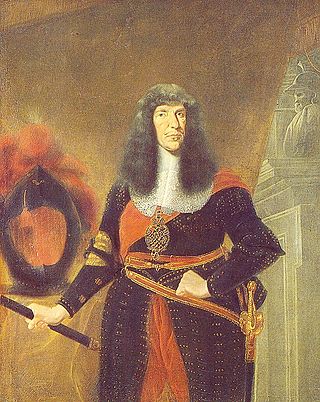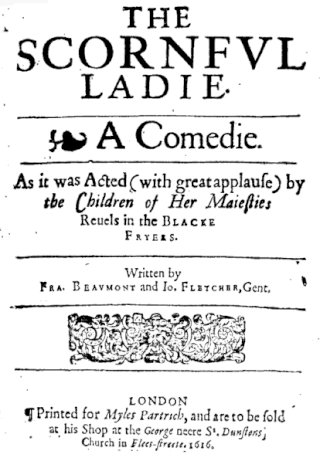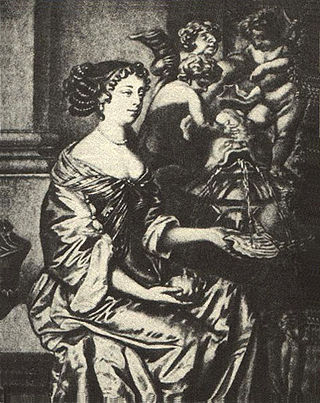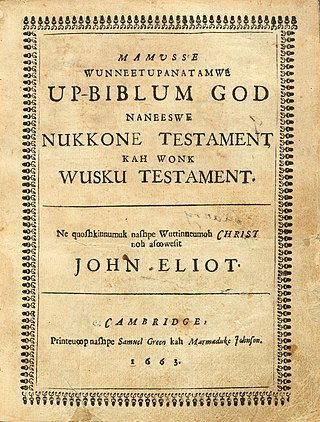Alice Broad was York's first female printer. She was also known as Alice Broade.
Alice Broad was York's first female printer. She was also known as Alice Broade.
Alice Broad was the assumed widow of Thomas Broad (seventeenth century York printer) and took over the family printing business on his death in 1661. [1] The press was located opposite the Ye Olde Starre Inne on Stonegate, York. [2]
Broad was York’s first female printer, [3] and indeed the only printer in York from 1661–1664. She remained the only female printer in the city for the duration of her career.
Works produced by Broad included religious publications, instructional books, visitation articles, local interest and a range of other subjects.
The last extant printing is generally considered to be Scarbrough-Spaw, or a Description of the Nature and Vertues of the Spaw at Scarbrough, Yorkshire, published 1667. [4] There is no definitive evidence of any further publications until the publication of Northumberland visitation articles followed by a book of poetry with John White in 1680. [5] John White married Hannah, the assumed daughter of John and Alice in 1680. [6]
York Minster Library houses eleven of the seventeen extant publications.
Broad's tools and presses went with Hannah Broad into her marriage with John White. [7]

William Bradford was an early American colonial printer and publisher in British America. Bradford is best known for establishing the first printing press in the Middle colonies of the Thirteen Colonies, founding the first press in Pennsylvania in 1685 and the first press in New York in 1693. Bradford operated continuously printing establishments for sixty-two years, heading a family that would include printers and publishers for 140 years. He was also known for controversies regarding freedom of the press. Starting his printing career in London, Bradford emigrated to America in 1685. He established, with others, the first paper mill to appear in the Thirteen American Colonies.

Vice-Admiral Thomas Butler, 6th Earl of Ossory, KG, PC, PC (Ire) (1634–1680) was an Irish soldier and politician. He was the eldest son of James Butler, 1st Duke of Ormond but predeceased his father and therefore never succeeded as duke.

Earl of Rothes is a title in the Peerage of Scotland. It was created in 1458 for George Leslie, 1st Lord Leslie. He had already been created Lord Leslie in 1445, also in the Peerage of Scotland. His grandson, the third Earl, having only succeeded his elder brother in March 1513, was killed at the Battle of Flodden on 9 September of the same year. His son, the fourth Earl, served as an Extraordinary Lord of Session. Lord Rothes was also tried for the murder of Cardinal Beaton but was acquitted.

John Playford (1623–1686/7) was a London bookseller, publisher, minor composer, and member of the Stationers' Company, who published books on music theory, instruction books for several instruments, and psalters with tunes for singing in churches. He is perhaps best known today for his publication of The English Dancing Master in 1651.

Richard Lumley, 1st Earl of Scarbrough, was an English soldier and statesman best known for his role in the Glorious Revolution.

Johann George II was the Elector of Saxony from 1656 to 1680. He belonged to the Albertine line of the House of Wettin.

Herbert Croft (1603–1691) was an English churchman, bishop of Hereford from 1661.

Richard Pynson was one of the first printers of English books. Born in Normandy, he moved to London, where he became one of the leading printers of the generation following William Caxton. His books were printed to a high standard of craftsmanship, and his Morton Missal (1500) is regarded as among the finest books printed in England in the period.

The Scornful Lady is a Jacobean era stage play, a comedy written by Francis Beaumont and John Fletcher, and first published in 1616, the year of Beaumont's death. It was one of the pair's most popular, often revived, and frequently reprinted works.
Thomas Welles is the only person in Connecticut's history to hold all four top offices: governor, deputy governor, treasurer, and secretary. In 1639, he was elected as the first treasurer of the Colony of Connecticut, and from 1640 to 1649 served as the colony's secretary. In this capacity, he transcribed the Fundamental Orders into the official colony records on 14 January 1638, OS,. He was the magistrate during the first witch trials, the Hartford or Connecticut Witch Trials.

Mary Saunderson (1637–1712), later known as Mary Saunderson Betterton after her marriage to Thomas Betterton, was an actress and singer in England during the 1660s and 1690s. She is considered one of the first English actresses.

Samuel Green was an early American printer, the first of several printers from the Green family who followed in his footsteps. One of Green's major accomplishments as a printer was the Eliot Indian Bible, translated by the missionary John Eliot, which became the first Bible to be printed in British America in 1663. Members of his family who also became printers include his sons Bartholomew, Bartholomew Green, Jr. and Joseph Dennie. Throughout his adult life Green also served in the Massachusetts Bay Colonial Militia, advancing to the rank of captain later in life.

Sir John Glanville the younger, was an English politician who sat in the House of Commons at various times between 1614 and 1644. He was Speaker of the English House of Commons during the Short Parliament. He supported the Royalist cause in the English Civil War.
Thomas Pierce or Peirse (1622–1691) was an English churchman and controversialist, a high-handed President of Magdalen College, Oxford, and Dean of Salisbury.
Jonathan I Rashleigh, of Menabilly, near Fowey in Cornwall, was an English shipping-merchant, Member of Parliament for Fowey in 1614, 1621, 1625, April 1640 and November 1640, and 1661 and served as Sheriff of Cornwall in 1627. He supported the Royalist cause during the Civil War.

Sir William Courtenay, 1st Baronet was an English politician.

John Foster was an early American engraver and printer who lived in Boston in the Massachusetts Bay Colony when the colony was still in its infancy. He is credited with producing the first printed image in British colonial America, from a woodcut engraving of the Puritan minister Richard Mather. He also printed the first map to appear in the colonies. Foster graduated from Harvard University, but was a self-taught pioneer in American printmaking in woodcut, and also learned the art of typography from the Boston printer Marmaduke Johnson. He subsequently printed many works by prominent religious figures of the day in Massachusetts, and for a few years printed and published an annual almanac. His woodcut engravings were also used for the printing of official seals of the Massachusetts Bay Colony used by the provincial government.

Sir John Coryton, 1st Baronet was an English politician who sat in the House of Commons from 1660 to 1680.

Thomas Gent (1693–1778) was a printer and writer, born in Ireland, who spent most of his working life in York. He authored several works, mostly histories, but was financially unsuccessful.
{{cite book}}: CS1 maint: multiple names: authors list (link)